| Piled Higher & Deeper by Jorge Cham |
www.phdcomics.com
|
|
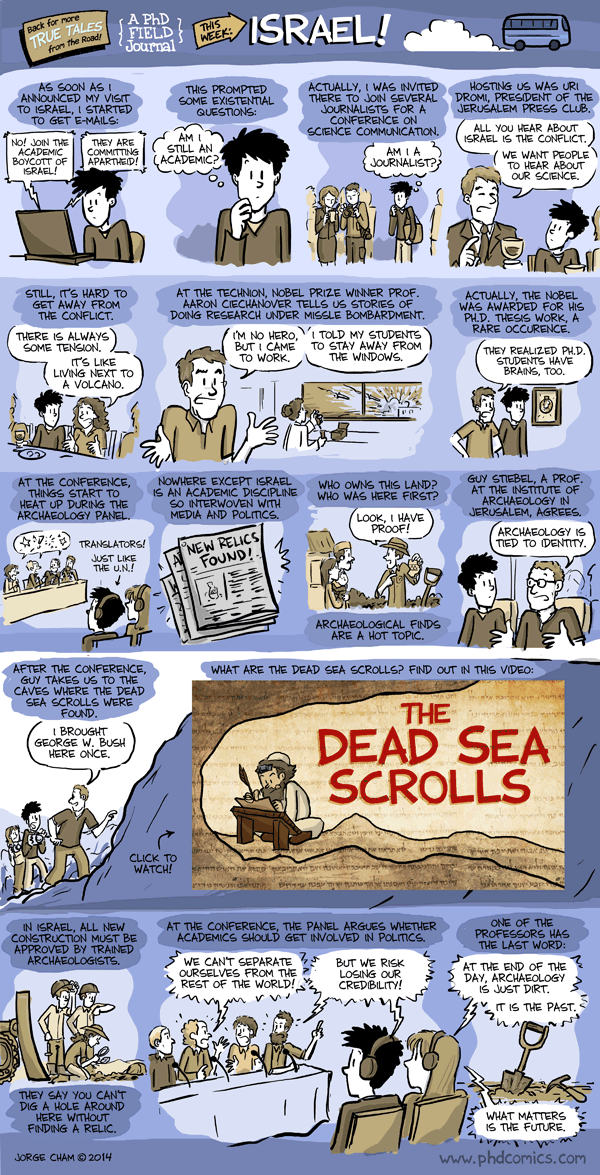 |
||
|
title:
"Academics, Politics and Identity" - originally published
2/24/2014
For the latest news in PHD Comics, CLICK HERE! |
||
Charming.goats
Shared posts
02/24/14 PHD comic: 'Academics, Politics and Identity'
Law Meant to Hurt Brown People Only Ended Up Hurting Everyone Equally, Including Whites!
How America’s harshest immigration law failed
Illegal is illegal.” With that rallying cry, Alabama passed HB 56 in 2011, the harshest state immigration law in the country.
The lead sponsor of the bill boasted to state representatives that the law “attacks every aspect of an illegal alien’s life.” Among its key provisions: landlords were banned from renting homes to undocumented immigrants, schools had to check students’ legal status, and police were required to arrest suspected immigration violators. Even giving unauthorized immigrants a ride became a crime.
The vast scope of the law turned Alabama into an unprecedented test for the anti-immigration movement. If self-deportation didn’t work there, it’s hard to imagine where it could. Early reports suggested success: undocumented immigrants appeared to flee Alabama en masse. But two years later, HB 56 is in ruins. Its most far-reaching elements have proved unconstitutional, unworkable, or politically unsustainable. Elected officials, social workers, clergy, activists, and residents say an initial immigrant evacuation that roiled their communities ended long ago. Many who fled have returned to their old homes.
Now Alabama is back where it started, waiting for a solution from Washington that may never come.
When HB 56 passed, Albertville—where the booming poultry industry had attracted thousands of immigrants from Mexico and Central America—quickly became the national face of the crackdown. From 2000 to 2010, the number of unauthorized immigrants in Alabama jumped from an estimated 25,000 to 120,000, as migrants flocked to jobs in agriculture, meatpacking, and construction.
Supporters of Alabama’s law argued it was necessary because Congress had repeatedly failed to pass a workable immigration policy of its own. “The illegals in this country are ripping us off,” state representative Kerry Rich, who represents Albertville, told reporters the day HB 56 passed. “If we wait for the federal government to put this fire out, our house is going to burn down.”
That concern drove Alabama to pass the nation’s toughest legislation but it is not alone in its desire to stem the flow of undocumented workers. Arizona, Georgia, and South Carolina have all passed similar laws over the last three years and legislatures around the country are debating more immigration-related bills.
If Congress once again fails to pass reform, more states will be tempted to fill the void with measures aimed at either integrating their immigrant communities or kicking them out. But as Alabama’s bitter experiment confirms, a go-it-alone approach is no substitute for a federal solution.
Car Crash
It took just six weeks after HB 56 went into effect for state legislators to start having second thoughts about their actions.
On November 16, 2011, police in Tuscaloosa stopped a driver for not having the proper tag on his rental car. Normally, this would have been a minor citation. But the driver did not have a license on him, only a German ID card, and that triggered what was supposed to be HB 56’s most powerful weapon against illegal immigration. Under the law, police were now required to arrest the man, haul him to court, and detain him until federal immigration authorities determined his fate, no matter how long that took.
As it turned out, the driver was an executive at Mercedes-Benz. The European car giant was one of several foreign auto companies in the state whose plants provide thousands of much-needed jobs.
The incident was soon followed by another traffic arrest involving a Japanese Honda worker. Together, the auto blow-ups sparked an outcry from the business community, who feared companies would pull out of the state. Pouring salt on the wound,the St. Louis Post-Dispatch ran an editorial inviting Mercedes to move their operations to the “Show-Me State” instead of the “Show me your papers” state.
More unintended consequences emerged, this time from the religious community. Churches complained the law’s ban on providing aid to undocumented immigrants could criminalize everything from soup kitchens to Spanish-language Sunday services.
“They were going to change Bible school into border patrol,” Scott Douglas, executive director of Greater Birmingham Ministries, told msnbc. “We had fewer Spanish-speaking congregants coming to our organization for help.”
At courthouses, simple tasks like renewing one’s vehicle tags now required proof of legal status, which generated long lines for citizens and non-citizens alike. Utilities were unsure whether they needed to cut off service to residents who couldn’t prove citizenship.
“People couldn’t get power or water, it was crazy,” Jeremy Love, an immigration attorney in Birmingham, recalled. “It got resolved, but it took pressure. I’d call managers and tell them it was a civil rights violation.”
County attorneys even questioned whether residents needed papers to use their public swimming pool – an uncomfortable prospect in a state still haunted by the legacy of segregation.
Silencio
There was some irony to the problems public servants’ rigorous implementation of the law had created. When lawmakers first passed HB 56, they were actually concerned that police might refuse to enforce it.
A number of police chiefs and sheriffs had strongly opposed the must-arrest provisions because they lacked the manpower to carry them out. Small town departments with just a few officers on staff were suddenly expected to devote hours of work to individual traffic stops that used to take 20 minutes to resolve. The departments also had to pay to keep suspected undocumented immigrants in jail while federal authorities looked into each case.
“I have a problem fundamentally with placing someone in jail over a traffic citation,” Brian Stillwell, chief of police in immigrant-heavy Clanton, told msnbc. He recalled one particularly frustrating instance in which he was forced to detain a nursing mother in a holding cell over a minor auto violation.
Doug Pollard, Albertville’s muscle-bound and mustachioed police chief, actually saw some positives in the new law when it passed. In recent years, buses had been caught in the area dropping off dozens of undocumented workers from Mexico and he found it easier now to coordinate with Immigration and Customs to resolve the cases.
But he quickly faced a new problem: Albertville’s Hispanic community stopped talking to the police – about anything.
“If they had a crime committed against them they used to come to us,” Pollard said. “Then this new law came out and they got scared. ”
Nothing in the law demanded police check the legal status of crime victims or witnesses, a fact Pollard desperately relayed to residents in media appearances, church meetings, and town halls. In fact, the federal government offers temporary visas to crime victims to encourage them to talk. But he couldn’t break the fear. Some residents started carrying “rights cards” stating their intention to remain silent, which they’d hand to officers as soon as they were stopped.
Love, the immigration attorney, said he had clients who were warned, incorrectly by police, that they’d have to reveal their legal status to report a crime. Clanton police officer Neil Fetner, who became the town’s unofficial expert on the law, said he frequently fielded calls from other departments confused by the requirements.
“There were a lot of false interpretations of the law – and then it would change or the courts would rule again,” Fetner said. “For a while it was memorandum city.”
The Law Shrinks
Politicians, tired of complaints from business, police, religious leaders and more, quickly called for changes.
“I’ve learned in life that if you make a mistake, you should be man enough to admit it,” Republican state senator Gerald Dial, who voted for the law, said shortly after the Mercedes arrest.
But fixing it meant backtracking on one of the central pillars of the law. Politicians were so eager to arrest undocumented immigrants that they included a provision empowering citizens to sue individual officers caught shirking their enforcement duties.
Seven months after the law went into effect, the state legislature passed a round of revisions. No longer were police required to arrest people for failing to produce a license and state residents could no longer sue them as easily. The new law also weakened requirements that residents show proof of legal status when dealing with the state, ending the mass confusion that had roiled state utility companies, courthouses, and other public offices.
By this point, however, lawsuits by the Justice Department, civil rights groups, and Alabama churches were already blocking large chunks of the remaining law.
In October 2011, less than two weeks after a judge let HB 56 go into effect, a federal appeals court temporarily halted its requirement that schools ask about students’ legal status – a prime driver of the initial panic. Meanwhile, Arizona’s SB 1070, the model for Alabama’s law, wound its way to the Supreme Court, where justices blocked police from detaining people just because they suspected they were undocumented, one of several key provisions they struck down.
In an effective act of surrender, Alabama settled its various lawsuits in October 2013 and coughed up $350,000 to cover their opponents’ legal bills. The rulings that forced their hand created precedents that will foil similar laws even faster should they arise.
“Alabama illustrated that illegal immigrants will respond to changed incentives,” Mark Krikorian, Executive Director of the Center for Immigration Studies and a backer of HB 56, told msnbc. “But states can’t follow through on those changes if the federal government is actively fighting them.”
Still Here
For Alabama’s immigrant communities, the early days of HB 56 were a harrowing experience.
“It was like a disease,” Jose Contreras, who owns a Hispanic grocery store in Albertville, recalled. “Everyone was panicking and leaving.”
But as provision after provision fell, it became clear that the original goal of the law – to expel the state’s undocumented immigrants – was not going to happen.
Interviews with a wide variety of groups, from residents, to advocates on the ground, elected officials to church leaders, suggest that the initial exodus of immigrants after HB 56 took effect was short lived.
“When it first went effect, people were afraid to go outside,” said Father Tim Pfander, whose St. William Catholic Church attracts hundreds of Latino worshippers. “Today, I think they’ve seen how it’s enforced and are carrying on with the laws.”
Few metrics can capture how the changes have impacted the community. But in Albertville, officials noted that the size and demographic breakdown of the town’s public school classes are mostly similar to what they were before HB 56. The story is similar statewide.
According to Alabama’s education department, the number of Hispanic students rose last year even as the overall student population declined. That wasn’t the plan. Proponents of the law had wanted to decrease the Spanish-speaking population, complaining that immigrant children were dragging down the school system.
While the restrictions eased over time, the initial passage of the law caused enough hardship to scar the immigrant community. Many recalled police roadblocks around their neighborhoods and said they adjusted their schedules to avoid unnecessary car trips. Some reported verbal abuse from strangers telling them to go home to Mexico. Longtime residents deferred opportunities for fear of the new law’s consequences.
“My daughter’s American and she had a scholarship to go to a state university, but we couldn’t let her go and she lost it,” said Rebecca Maciel, who moved to Alabama 17 years ago with her husband. “If they picked us up who would take care of her siblings?”
Vincente Gonzales blamed the law for forcing his wife out of a job after her employer cracked down on undocumented hires. Unable to work his usual construction jobs due to failing kidneys, Gonzales said his son also deferred acceptance at a state university to help support the family.
But after 18 years on U.S. soil, he laughed when asked whether he’d consider moving back to Mexico.
“Our lives are here already,” Gonzales said. “Besides, Hispanics have a fighting heart.”
Despite their difficulties, immigrants said their primary motive for staying was the hope that their children, many of whom were born in Alabama and have thick southern accents to prove it, would find success.
“My daughters are 7 and 4 and they ask why we don’t leave if they treat us so badly,” Natividad Gonzalez, an activist with the Alabama Coalition for Immigrant Justice, said in an interview. “All I can say is: ‘This is your home.’ They’re what motived me to stay, because I know they’re protected. Maybe not me, maybe not my husband, but they are.”
By contrast, their old hometowns in Mexico are not only economically stagnant, but dangerous enough that they almost consider themselves refugees. Many come from cities plagued by drug violence, and they fear their extended time in America would make them obvious kidnapping targets.
“I’d only go there to die,” Gonzales said.
The Wave Passes
HB 56’s authors have defended the remaining law’s value, pointing to certain provisions that remained intact including a requirement that companies check new hires’ legal status against a federal database. They credit HB 56 with a drop in unemployment in recent years, although economists in the state argue that it’s unrelated. Police can still check the immigration status of people they pull over even though they are limited in their ability to detain them.
Among state and local officials, the anti-immigration fever that led to the law’s passage has substantially subsided.
In 2008, Albertville’s local elections were dominated by calls to stop illegal immigration. But by the time the 2012 elections rolled around, the main proponents of the anti-immigration push, Councilman Chuck Ellis and Mayor Lindsey Lyons, were voted out of office along with every incumbent except Council president Nathan Broadhurst. Immigration was barely an issue in the race.
Broadhurst, along with current Mayor Tracy Honea, takes a more moderate stance on the issue. He said a turning point for the city government was when Kris Kobach, the Kansas Secretary of State considered the intellectual force behind self-deportation, offered his services to help them sue businesses for profiting off illegal labor. The council voted his proposal down 3-2.
“The majority of us felt like it was counterproductive to try and go after local industries,” Broadhurst said. “Especially industries that are so vital to the tax base of the city.”
Honea and Broadhurst believe Albertville has reached a detente as the city’s different communities interact more.
“Certainly I think it changes the dynamics of a town,” Honea said of the last two decades of immigration. “But I think the community as a whole has grown and learned a lot. For the most part they’ve embraced the reality of what it is.”
After two years of turmoil, undocumented immigrants aren’t leaving Alabama. But they still live in fear of deportation and have no obvious way of becoming full-fledged Americans.
“I think God brought us to this country for a reason,” Yaneth Rangel, who emigrated from Veracruz, said. “We need an amnesty. We need a solution.”
Bilbo Baggins Is a Girl
The first time she made this claim, I protested. Part of the fun of reading to your kids, after all, is in sharing the stories you loved as a child. And in the story I knew, Bilbo was a boy. A boy hobbit. (Whatever that entails.)
But my daughter was determined. She liked the story pretty well so far, but Bilbo was definitely a girl. So would I please start reading the book the right way?
I hesitated. I imagined Tolkien spinning in his grave. I imagined mean letters from his testy estate. I imagined the story getting as lost in gender distinctions as dwarves in the Mirkwood.
Then I thought: What the hell, it’s just a pronoun. My daughter wants Bilbo to be a girl, so a girl she will be.
And you know what? The switch was easy. Bilbo, it turns out, makes a terrific heroine. She’s tough, resourceful, humble, funny, and uses her wits to make off with a spectacular piece of jewelry. Perhaps most importantly, she never makes an issue of her gender—and neither does anyone else.
Despite what can seem like a profusion of heroines in kids’ books, girls are still underrepresented in children’s literature. A 2011 study of almost 6,000 children’s books published between 1900 and 2000 showed that only 31 percent had female central characters. While the disparity has declined in recent years, it persists—particularly, and interestingly, among animal characters. And many books with female protagonists take place in male-dominated worlds, peopled with male doctors and male farmers and mothers who have to ask fathers for grocery money (Richard Scarry, I’m looking at you). The imbalance is even worse in kids’ movies: Geena Davis’ Institute on Gender in Media found that for every female character in recent family films, there are three male characters. Crowd scenes, on average, are only 17 percent female.
More insidiously, children’s books with female protagonists sometimes celebrate their heroine to a fault. Isn’t it amazing that a girl did these things, they seem to say—implying that these heroines are a freakish exception to their gender, not an inspiration for readers to follow. Children’s lit could benefit from a Finkbeiner test. (Well-intentioned kids’ media can, ironically, introduce their youngest listeners and viewers to gender barriers: The first time my daughter heard the fabulous album Free to Be … You and Me, she asked, “Why isn’t it all right for boys to cry?”)
So Bilbo, with her matter-of-fact derring-do, was refreshing. With a wave of my staff I turned Gandalf into a girl, too, with similarly happy results. I started to fool around with other books and their major and minor characters, sometimes by request and sometimes not. In The Secret Garden, Dickon, the animal-loving adventurer who rescues Mistress Mary, became Mary’s best friend Diana. In the Finn Family Moomintroll books, the Snork Maiden and her brother the Snork traded genders. In the Narnia series, Peter Pevensie and his sister Susan made the pronoun switch. (That was a nice fix for the infamous line about Susan’s abandoning Narnia for “nylons and lipstick and invitations.”)
Friends tell me they pull similar tricks while reading to their sons and daughters: Women who farm become not “farmer’s wives” but “farmers.” Male animal characters become girls, and vice versa. Sleeping Beauty goes to MIT. Their kids, boys and girls alike, get to hear about a world as full of women as the real one—and as free of stereotypes as we’d like ours to be. Kid-lit may be catching up to our kids, but we don’t have to wait for it.
My daughter might forget all about the heroines and heroes she helped create. But she might not. I hope that years from now, when she has a chance to take her own unexpected journey, she’ll remember the story of Bilbo—and be a little more inclined to say yes.
Source
The Fascinating Story of Why U.S. Parks Are Full of Squirrels
As a new paper published the Journal of American History by a professor at the University of Pennsylvania named Etienne Benson explains, the story of America's squirrels goes back to the early 19th century. At that point in time, squirrels were just another animal running around the woods, mainly useful as a source of food for frontiersmen. If you saw a squirrel in the city, it was almost certainly being kept as a pet. One escaped pet squirrel in New York City, circa 1856, drew a crowd of hundreds according to one of the city papers—which called the squirrel an "unusual visitor."
Around the same time, a sea change in our relationship with squirrels was already underway in Philadelphia. The city had released three squirrels in Franklin Square in 1847 and had provided them with food and boxes for shelter—and the people loved it. One visitor is quoted as saying "it was a wonder that [squirrels] are not in the public parks of all great cities." In the years that followed, the trend spread to Boston and New Haven, where squirrels soon grew so fat from humans feeding them that they were falling out of the trees. Cities even started planting nut-bearing trees so that the squirrels would have their own food source.
The squirrel fad really took off in the 1870s, thanks to Frederick Law Olmstead's expansive parks. Benson says that the movement to fill the parks with squirrels "was related to the idea that you want to have things of beauty in the city, but it was also part of a much broader ideology that says that nature in the city is essential to maintaining people's health and sanity, and to providing leisure opportunities for workers who cannot travel outside the city." These squirrels were possibly the only wildlife the workers would ever see.
Central Park led the way in the second wave of squirrels introduced into American cities. A small number of squirrels planted in the park in 1877 soon grew into a sizable population. By the time it had reached an estimated 1,500 squirrels six years later, authorities even talked about culling the population so that it didn't get out of control. At the same time, squirrel populations were growing around the country, with squirrels gracing the lawns of both Harvard Yard and Washington D.C.'s National Mall.
Feeding the squirrels became a past time during these years, and was eventually seen by naturalists and conservationists as a way to help humans learn how to better treat animals. It wasn't just confined to parks at this point, either. There are many accounts from the late 19th century of people in the suburbs feeding squirrels. Ernest Thompson Seton, who helped found the Boy Scouts, even wanted to use feeding squirrels as a way "to cure boys of their tendency toward cruelty."
So next time you see a squirrel in the park, drink it in. (Not literally of course—one should never drink squirrels.) These little critters were put there for your entertainment. But perhaps more importantly, they were put there to remind us of how man and nature must get along, even if it takes a little effort. Though honestly, how much effort does it take to throw a squirrel an acorn?
source: Gizmodo
The 20 page academic article on squirrels in the Journal of American History that Gizmodo is summarizing
something light and fluffy, very fluffy, for anyone stressed out by holidays, finals, or all the rage inducing articles this week. relax and procrastinate with the history of urban squirrels! The much longer scholarly article is worth a read for interesting analysis of changing attitudes towards nature, charity, and how this tied into development of laws about animal cruelty
Dr. Grumpy's gift guide
What could make a cupcake even more appetizing than it already is? More frosting? Sprinkles? Realistic sores from sexually-transmitted diseases?
 |
| Mmmmm... chancres. |
These delectable "clapcakes" are available in Gonorrhea, Syphilis, Herpes, and, um, a handful of other reasons to use condoms.
Bon Appetit!
http://ontd-political.livejournal.com/10826573.html
Charming.goatsFlorida is at the top of a good list for once! :D
Henry Louis Gates on his PBS series, teaching anti-racism, and why we don't need a "conversation on race"
Henry Louis Gates is on a mission to change how race is taught in America.
The Harvard professor of African and African-American studies is among the most public thinkers on the issue of race in the nation; his stature is only set to grow with the PBS series “Many Rivers to Cross,” which begins airing on Oct. 22. The six-part series considers the black experience in America from many angles, starting from the beginning of the North American slave trade.
Gates intends the series to help teach race in what he considers to be an utterly ineffective school system; he’s quick to cite studies indicating that black history is not being taught well in schools. Indeed, in a conversation with Salon, Gates indicated that he believes certain states ought to mandate black history education in schools.
But the real conversation Gates wants to be having is one about class. He spoke to Salon about the degree to which the end of legal segregation led to the splintering of the civil rights movement as well as to further inequities on a national level, and what the government needs to do to ensure a fair shot for all citizens. Here’s a hint — it’s not a “conversation on race” of the sort convened after Gates was arrested trying to enter his Massachusetts home. In fact, he hates the term. A meaningful conversation, Gates told Salon, “can only happen if nobody uses the worlds ‘conversation about race.’”
I really enjoyed watching the first episode.
You know, I just watched it myself, with my girlfriend. And I really liked it.
Were you surprised that you liked it? Do you sometimes not like things that you’ve done as much?
No, no; I always like them. But I always wait. You know, I write the script, I’m the host, I’m the narrator. But seeing the final package is always a completely different experience. This one I put it off, put it off, put it off and finally said, “OK, I’m going to watch it.” So my girlfriend and I watched it this morning, in preparation for you and I was really delighted. It was just great.
I’m kind of curious the degree to which you think we as a nation — especially students — are at risk of forgetting slavery. I wonder if this series has to exist and things like it have to exist to remind people?
I think of this as a black history series for your generation. A generation that didn’t see “Roots” when it was being shown every night creating a national phenomenon. A very cosmopolitan generation, technologically savvy. Less concerned about race as an individual basis than any generation before it. And more integrated – socially integrated, whether it’s images on television or as the definition of American popular culture adds the African-American element as its lingua franca.
But on the other hand, schools are failing in terms of teaching the black experience. We don’t have to be anecdotal about these things. The Southern Poverty Law Center recently issued a report – and you can Google this – on how well the civil rights movement, just the civil rights movement – you’d think with Martin Luther King Day and February as Black History Month, how many times do you hear “I have a dream” in the month of January and February? A million times – you’d think that the one thing that the schools would be doing right, and covering adequately, would be the civil rights movement, right?
Wrong. Only three states received an “A”: Alabama, Florida and New York. And only three even received a “B”: Georgia, Illinois and South Carolina. For adequate coverage of the civil rights movement. Thirty-five states received an “F,” including the great state of California. You can imagine if they did a similar survey of slavery, the results would be even worse. Part of the reason for that is that I don’t think teachers have had, I know they don’t have one DVD of a series that they can use for their multimedia element. And that’s because no one has tried to do a comprehensive survey of African-American history since 1968, since Bill Cosby did “Black History: Lost, Stolen or Strayed,” which I watched with my parents in Piedmont, W.Va., when I was 17 years old. And that’s what inspired me to go to Yale and take a black history course, in fact, the following year.
Teachers need tools to integrate the content about the black experience. And this series is the only one crazy enough to do what turned out to be 500 years of African-American history. Starting, as you saw, with Juan Gurito, first black man to set foot on what is now Florida in 1513 with Ponce De Leon looking for the fountain of youth. All the way to Obama’s, President Obama’s second inauguration. Heretofore, teachers would have to use “Eyes on the Prize,” which is on the civil rights era, and “Slavery in America,” and “Freedom Riders” by Stanley Nelson, and something on the Harlem Renaissance. So what I decided to do was tell the story in one series using salient stories – 70 stories over the six episodes, which were exemplary of the whole larger experience. So I worked for seven years on the series, and we gained 30 or 40 stories. When we started, we had a list of the indispensable, canonical stories that any series would have to tell. [laughs] And so we spent years whittling down the stories to be the essential ones, and that’s what we came up with.
I wonder if there will come a point when the kind of scars on the nation from slavery are gone. When the stain on the national conscience is ameliorated. It seems to me that we’ll never be past it! It’s too horrible.
Well, do you think the pains of the Civil War have been ameliorated or abated yet?
I don’t, personally.
Well you know, that’s it. Whenever I think they have, all I have to do is look at someone on TV from the right who is from the South, who is still metaphorically fighting the Civil War. Or when you see the people lifting the Confederate flag, or 1,001 other manifestations that it’s still an open wound. What I hope we can achieve is more distance on it. And I think that’s what you’re implying, what you’re getting at — that we can see it more objectively without blaming people. Or holding a descendant of someone who fought for the South responsible, if you’re an African-American, for slavery or for the suffering of one’s ancestors. If we could chalk it up to history the same way we do terrible things in each era of history — are people actually bleeding about the Seven Years’ war or the Hundred Years’ War, the War of the Roses in England? You know, OK, we’ve moved on 500 years later.
I think one of the other reasons that I wanted to make this series, is that we’re living in the time – the best of times and the worst of times – we have a black president, statistically the black upper middle class has quadrupled since 1968 when Dr. Martin Luther King was killed. But on the other hand, the percentage of African-American children living at or beneath the poverty line is just slightly less than when Dr. King was living. And we have more black men in prison than Martin Luther King, Du Bois or anyone else could have ever imagined. We have this huge black-white wealth gap, but we also have a black-black wealth gap between the black haves and have-nots. So how did we get to this curious place? That’s why I wanted to make this series and the roots go back for that 500 years with a lot of twists and turns. I wanted to create a tool. It could be used in a classroom to facilitate a true conversation about race, we could talk about what I mean about that. I wanted it to be an explanatory agent, in terms of helping us understand the paradoxical contradictions that we have today in our society between more black people doing well in every field and so many black people doing terribly. How did we get here?
Does it drive you crazy when people refer to ours as a post-racial society?
It drives me nuts! I can’t even imagine what it means. I don’t even want to be in a post-racial society. You know, I’m a professor of African studies and African-American studies, and I do very popular PBS television shows, in terms of excavating people’s roots …
What’s your heritage, by the way? Your ancestral heritage? You’re Italian?
Yes.
And it’s very important. It was very important to Mario Batali when I introduced him to excavated ancestors of hundreds of years. It’s crucial. I don’t want there to be a time when we’re colorless. I just don’t want your Italian heritage and my African heritage and Irish heritage, in my case, to be used to limit your possibilities or mine to limit my possibilities. When you could wear your ancestry, your sexual preference, your gender orientation, your religion, your color, what have you – you can wear it without penalty. And that’s what, that’s what situation we haven’t achieved in this country. It still matters that you are black or gay or a woman or Jewish, and I’m sure Italian, in some contexts. In terms of the presidency, it can be gotten rid of by waving a wand, or even by electing an Italian president, a Jewish president or a black president.
How would you change the manner of how history, and particularly racial history, is taught? If you had the opportunity to put into place your own curriculum all across America, what would you do?
I would do two things. One: African-American history would be completely, thoroughly integrated into American history. That’s not yet done sufficiently. So that the story would be much more complex. We need the story of George Washington, but we need the story of his slave at the same time. Which is the story we told in Episode 1. Metaphorically, if you have “American Bandstand,” you need to have “Soul Train,” which is what we do in Episode 6.
There’s too much whitewashing of our founders, for example. George Washington has more slaves than any other president, than the first five presidents, and didn’t free them until his deathbed. We need to tell these stories without blame and show how complex our heroes of American history were. The second thing we need to do, I would like to see, in some states, black history courses mandated. I would like to see that done. In part because black history has been excluded for so long, and because it is such a fundamental part of American history, that we have to do a dramatic corrective. So I would like to see a high school class — I wouldn’t do it until then — a high school class on African-American history mandated throughout the country.
A lot of organizations like the NAACP seem to have lost some of their status as thought-leaders. They’re not where people turn for information or for advocacy first, necessarily. And I’m wondering if a certain sense of solidarity has been lost and if that’s a bad thing.
I think that the problems of race and class have been, are so inextricably intertwined — but because of segregation, because of legal segregation, our political organizations only identified race as a cause. So once segregation was dismantled with Brown v. Board of Education, and the Voting Rights Act and the Civil Rights Act of 1965, et cetera, there was a naive belief that all African-Americans would plunge headlong into the middle class. But that’s obviously not what happened. And as I’ve said and you know, affirmative action created an upper middle class, which I’m a part of, and all those people were left behind. So I think that the leaders of our traditional civil rights organizations have been scrambling for a new analysis.
Because if you think about it, since slavery ended, all political movements have been about race. If you think about the economics of the Black Panthers but they were annihilated, right. There were black socialists in the 1920s under A. Philips Randolph, and there were black Communists. And I’m certainly not advocating Communism or socialism, but they were at least talking about the role of economics even if they didn’t get it right. Martin Luther King only at the end was talking about it — despite the fact that the March on Washington was for jobs, and equality, specifically, in employment. It was only at the end that he was realizing that race was only part of the issue. I would say that the traditional organizations like the NAACP, which was under the great leadership of Benjamin Jealous, and Marc Morial and the Urban League, etc. They are reformulating the agenda and they are still in the process of doing that.
Have we lost unity? Yes. I think that the black community, like other ethnic communities, has 100 percent unity when it comes to a race issue. When it comes to voting in a black president, it was overwhelming, 95 percent unity. When it comes to the class differences within the race, there is a lot of variation in lifestyle, possibility, where your kids go to school, how they’re treated where you live. Whereas before you could have a doctor and a maid living next door to one another because the neighborhoods were segregated. So yes, to answer your question, the black community has become fissured in ways that generations before the 1960s couldn’t imagine. Culture — shared cultural values — creates more of an illusion of unity, which is belied by economic differences, life choices, responsibility. One of the places in my series to show that there has always been a variation, a lack of unity in the black experience. From the time the first few black people showed up, some were free and others were slaves. And that’s a difference between 1513 and 1528, so I wanted to show that diversity.
Nobody talks about how there are more black Americans than there are Canadians, but everybody talks about “the black community.” Nobody in their right mind talks about “the Canadian community” as though all Canadians are going to speak with one voice and one mind. But on the other hand, that’s how we talk about black Americans. And black America is just too diverse for that. I think that because of that and because of the economic diversity today, there is a lot of nostalgia for the world of segregation, when it seems like the community was more unified. But the challenge is for our political leaders to formulate an agenda that takes into account race and class. And that is what we’re seeing today.
Can I go back to the little riff I wanted to make about the conversation on race?
Sure.
Everyone talks about the “conversation on race.” Every time we need a “conversation on race.” The only place where a meaningful conversation with long-term impact can happen is in the schools, and can only happen if nobody uses the words “conversation about race.” What do I mean by that? Schools are the vehicle to create citizenship and you learn it osmotically. Nobody says, “Daniel, I’m going to teach you to be a good citizen.” You learn the Pledge of Allegiance, “My Country ‘Tis of Thee,” “America the Beautiful,” George Washington chopped down the cherry tree and never told a lie. All of this is how we become citizens. And what’s been left out of that conversation is race, honest conversations about race. But not feel-good talk. I’m talking about [the slave] Harry Washington and George. I’m talking about the economic role of slavery in the creation of America. The fact that the richest cotton-growing soil happened to be inhabited by five civilized tribes, what they called themselves, and that had to be exterminated, removed and or exterminated for the greatest economic boom in American history to occur. The Trail of Tears, the cotton boom from 1820 to 1860. I’m not talking about politically correct history, I’m talking about correct history. I just made that up — I have to write that down.
That’s how to have a conversation about race, when it happens every day, it happens every day osmotically. Just in the atmosphere, as a normal part of the discourse in the classroom talking about shaking up America. Instead of – I’m 63, and the only black history we ever got was called “Slavery Day” and the teacher would say, “Well, there was slavery and it was the best thing to happen to you people. You were eating each other and swinging through trees.” I went to an integrated school in 1956. And it was embarrassing, I didn’t know anything about black history until Bill Cosby’s in 1968, really. So I want this series to contribute to real conversation in the classroom precisely by making it unnecessary to use those specific words.
I’m curious about the tendency of white people to point at exceptional African-American celebrities, like Oprah Winfrey, Denzel Washington, Barack and Michelle Obama, Will Smith, as examples of people who made it, and to refer to them as “good examples.” I find myself wincing when I hear rhetoric like that, because the implication is shaming in a way to every African-American who isn’t Oprah Winfrey.
Many of those people you mentioned are friends of mine and I’m very happy for their success. But their success is not typical of the African-American experience. And there have always been exceptions. Remember that first episode, I talk about Anthony Johnson? He’s a slave who gets freedom, he gets married, he and his wife get their freedom. He accrues 250 acres and even, in the year 1864, takes a black man to court who was working for him, proving that the man is his slave and not an indentured servant. So there have always been exceptions from the get-go.
That’s a handful of superstars and millionaires you’re referring to. But even if you look at that black upper middle class that has quadrupled since 1968, it’s still exceptional. It’s still a small group of people and it still has much less wealth than its white socioeconomic counterpart. What we all need to strive for is a bigger middle class that’s more integrated. So we need to focus on jobs. We need a jobs bill. We need to figure out how to reform vocational education so that it produces people with the skills needed for a 21st century highly technical economy. And that’s not what we’re doing right now.
I don’t know if you saw protesters waving the Confederate flag in front of the White House. Will the Republican Party make it difficult to implement a jobs bill of the sort you propose, one that would help particularly the black middle class or lower middle class, because of a sort of inherent racism? Can they outgrow that in a matter of time?
I would say I know many Republicans who aren’t racist, and I wouldn’t want anyone to think that I was equating being a Republican with being a racist. But I know that the criticisms of Obama are definitely rooted in anti-black racism. And I think it is incumbent upon both the left and the right to see part of the problem and figure out how to help poor people, how to help working-class people, whether they’re black or white. Even affirmative action. I grew up with poor white people in the hills of West Virginia, I want affirmative action applied to them as well. When I started at Yale in 1969, affirmative action was a class escalator. And I want to see affirmative action be a class escalator for everyone, not just black people.
But again, it goes back to the classroom. You can’t just call these people out and say, “You’re a racist,” and expect them to change. In children, you get them in the classroom in first grade and we’re teaching them the nobility of the human spirit in black faces as well as white faces and not drawing attention to it; we’ll be showing them through a truly integrated curriculum that is the last great hope for the obliteration of racism in America. Because American popular culture has been integrated since the 1950s and 1960s, and under hip-hop in an extraordinary sense. It’s not like white racists don’t listen to black music, or cheer on black athletes, or attend movies with black characters. There’s a kind of switch that turns off; the switch is called economic fear. The people are threatened, they’re afraid for the future of their children. If you’re afraid. If I have I pie, and I have enough to go around, Mr. D’Addario, you are welcome to come to dinner. But if I think that you eating my pie is going to keep me from eating it, or my children, I’m sorry. Not only are you not going to come to dinner, but I also might be talking bad about Italians.
And that’s what happens. Under Lyndon Johnson we had guns and butter, we thought we had enough prosperity to put everybody in the middle class, and as soon as that dream fell apart, people once again started demonizing one another. Slavery was about economic relations, it was easy to demonize a group of people who looked so starkly different. As scarcity increases, so will racism. So will anti-Semitism. So will homophobia. That’s why schools are essential in countering the kinds of attitudes, unfortunate attitudes, children pick up in their living rooms from their parents.
Another Day, Another Walk
Charming.goatsasd;lfjkas;dlkj ADORABLE. (Also, why did no one talk me into teaching Potter how to walk on a leash???)


Our walk was brief.
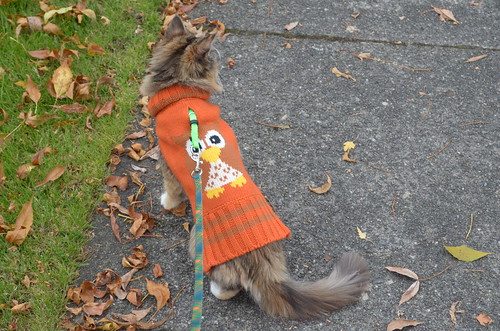
I had intentions of walking the length of the sidewalk on our block.

But instead, we walked the width of the sidewalk.
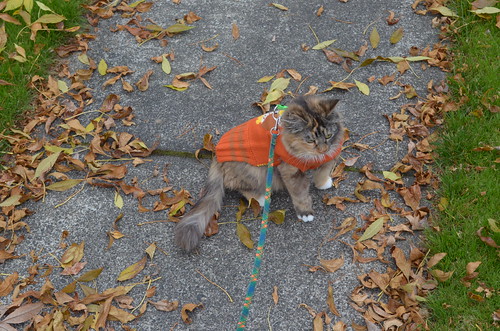

And sat in the leaves and grass.

Sixth Grader’s Father Says She Wouldn’t Have Died If A School Nurse Had Been On Duty
Laporshia Massey, a 12-year-old girl from Philadelphia, died on September 25 after an asthma attack went untreated at her school. Her father says that she would have lived had there been a school nurse there to treat her — but there wasn’t one, thanks to budget cuts in the Philadelphia school system.
Daniel Burch, Laporshia’s father, took his story to the Philadelphia City Paper this week. He explained that he got a call from his daughter’s school saying she was having an attack, but he had no idea how serious things were. The school, meanwhile, was telling his daughter to just “be calm.”
It was only only after Laporshia got home that Burch realize she needed to be rushed to the hospital. He took her in his car and, when she collapsed on the way, he pulled over and flagged an ambulance down in the middle of the street. But it was too late.
“If she had problems throughout the day, why … didn’t [the school] call me sooner?” Burch is left asking, “Why… didn’t [the school] take her to the hospital?”
Burch suspects that no one called him about his daughter’s deteriorating asthma problems because there was no trained professional to identify just how serious they were. He’s right: The school only has a nurse on staff two days a week. Like many schools around the country, the city’s dire funding situation has hit school nurses especially hard.
In fact, one quarter of schools in the United States have no school nurse at all. Philadelphia is one of the cities that knows that too well. Budget cuts brought the total number of school nurses in the city down by 100 (PDF) for the 2011-2012 school year.
That means 900 school nurses are serving 200,000 students in Philadelphia schools. And it’s leading to dangerous situations: An estimated 52 percent of kids report not receiving urgent medical care, while 36 percent are not getting medications or treatments at prescribed intervals. When kids are getting help, it’s not from people who necessarily know what they’re doing. Seventy percent say they’re getting medical care from untrained teachers.
Source
OP: Today is 'Depressing News Day'.
10/11/13 PHD comic: 'Post-Doctor Who, Pt. 3'
| Piled Higher & Deeper by Jorge Cham |
www.phdcomics.com
|
|
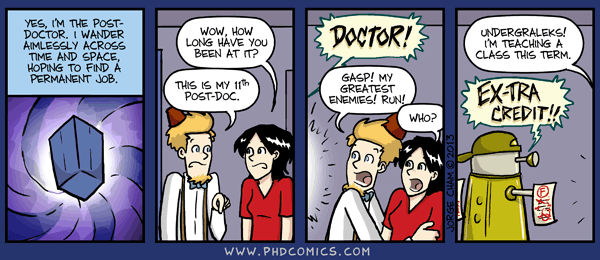 |
||
|
title:
"Post-Doctor Who, Pt. 3" - originally published
10/11/2013
For the latest news in PHD Comics, CLICK HERE! |
||
Venomous dinosaur discovered
Though a far cry from the movie's venom-spitting Dilophosaurus, the 125-million-year-old Sinornithosaurus may have attacked like today's rear-fanged snakes, a new study suggests.
Rear-fanged snakes don't inject venom. Instead, the toxin flows down a telltale groove in a fang's surface and into the bite wound, inducing a state of shock.
In Sinornithosaurus fossils, researchers discovered an intriguing pocket, possibly for a venom gland, connected to the base of a fang by a long groove, which likely housed a venom duct, the study says. Sinornithosaurus fangs also feature snakelike grooves in their surfaces.
"The ductwork leading out of the venom gland gave the venom a way to travel to the base of the teeth, where the venom welled up in the grooves," said study co-author paleontologist David Burnham of the University of Kansas Natural History Museum and Biodiversity Research Center.
"So when they sank their teeth into tissue of the victim, it allowed the venom, which was really enhanced saliva, to get into the wound."
Dinosaur's Venom Stupified Prey?
Turkey-size Sinornithosaurus, which likely had feathers, lived in the forests of what's now northeastern China, and was a member of the family Dromaeosauridae, as was another Jurassic Park baddie, Velociraptor. Birdlike Sinornithosaurus probably used its longish fangs to put the bite on prehistoric birds, Burnham said.
Like rear-fanged snakes and some lizards, the dinosaur probably had nonfatal venom that could shock its victims into a defenseless stupor—allowing Sinornithosaurus to eat in peace.
Dragons, Dinosaurs, and Venom's Shadowy Past
Burnham's research was inspired by the 2000 find of another possibly venomous dinosaur fang and by a recent discovery that the today's top lizard predator, the Komodo dragon, has a venomous bite that weakens victims so they can be eaten later.
Though believed to have descended from dinosaurs like Sinornithosaurus, today's birds are toothless and so lack a venom delivery system (though some birds do have toxic skin and feathers).
But Burnham is more interested in where Sinornithosaurus' venom ability came from than how it evolved.
"How primitive is venom really? Does it go all the way back to the archosaurs?" he said, referring to reptiles thought to have predated dinosaurs by 30 million years or more. "These are things people haven't really tested yet."
source has a picture of the skull
Mini Travel Guide: The Orkney Islands
Charming.goatsI want to go!
Hi, I'm Charlotta. I'm a freelance journalist from Finland living in the UK. My Scottish husband and I travelled up to the Orkney islands north of Scotland for our honeymoon. The islands are filled with history and legends. They're also truly wild places and the landscape has been battered by winds and the sea for thousands of years.
Thanks so much for sharing, Charlotta! Have any of you guys been here? Any tips to share?
Mary's desk, Tuesday afternoon
Mrs. Bland: "Hi, this is Katie Bland. Our daughters are in kindergarten together, and had a playdate last weekend at Local Park."
Mary: "Yes, she had a good time. I remember, you and I talked about the school's fundraisers."
Mrs. Bland: "Yeah. Anyway, my husband and I were wondering if you and your fiancé are interested in swinging with us at the Daisy Chain Club this weekend?"
Southwest Steak Bowls
Charming.goatsSaving for later
I came up with this recipe because I had half of a flank steak in my freezer that I needed to use up. As usual, I bulked up the meat with beans, rice, and other yummies, so that the one pound (or less, actually) covered four servings. I really had a hard time deciding what to put in these bowls because there were just SO many delicious possibilities. So, I’ll tell you what I put in mine below and then give you some other options!
I started the bowls with a base of brown rice cooked in chicken broth. The chicken broth makes a big difference in the overall flavor of the bowl. Feel free to use white rice, I just wanted to try to incorporate more brown rice into my diet lately. I topped the bowls with black beans, corn, freshly made pico de gallo, cumin-lime marinated flank steak, a dollop of sour cream, and a few sprigs of fresh cilantro. It was so. good. oh. my.
So here are some other ideas: avocado (or an avocado/sour cream sauce), your favorite salsa (instead of the pico de gallo), fresh or pickled jalapeños, satuéed onions & peppers (for a fajita style bowl), sautéed mushrooms, or shredded cheese. Basically, anything that you like in a burrito or on a taco would be amazing on this free-form bowl. Be creative!
Southwest Steak Bowls
- ¾ – 1 lb. flank or skirt steak $4.48
- 1½ Tbsp olive oil $0.32
- 1 clove garlic $0.08
- ½ tsp ground cumin $0.03
- ¼ tsp salt $0.02
- 1 medium lime $0.33
- 1½ cups uncooked brown rice $0.56
- 3 cups chicken broth $0.21*
- 1 small onion $0.32
- 1 large tomato $1.06
- ½ bunch cilantro $0.50
- ¼ tsp salt $0.02
- 1 (15 oz.) can black beans $0.63*
- 1 cup frozen corn kernels $0.47
- 1 (8 oz.) container sour cream $1.47
- To make the steak marinade, mince the garlic and combine it in a bowl with the olive oil, cumin, salt, and the juice from half of the lime (1-2 Tbsp juice). Save the other half of the lime to use in the pico de gallo. Add the marinade and steak to a zip top bag or shallow dish, make sure the steak is well coated in the marinade, and refrigerate it for about 30 minutes while the rice cooks.
- Cook the rice according to the package instructions, but substitute chicken broth for the water.
- While the rice is cooking and steak is marinating, prepare the pico de gallo. Dice the tomato and half of the onion. Combine the diced tomato, onion, juice from the second half of the lime, ¼ tsp of salt, and a handful of roughly chopped cilantro in a bowl. Stir until combined, taste, and adjust the salt if needed.
- Rinse the black beans in a colander and allow the corn kernels to thaw.
- To cook the steak, heat a large skillet over medium-high until very hot. Add the steak and cook for 3-5 minutes on one side, or until deeply golden brown. Flip and cook in the same manner on the second side. Transfer the steak to a cutting board and allow it to rest for five minutes. If desired, thinly slice the second half of your onion and cook it in the skillet for a few minutes, or until they are caramelized.
- Once the steak has rested for a few minutes, slice it thinly against the grain (look for the lines in the meat and cut across them). To build the bowls, lay down one cup of rice, ¼ cup each of beans, corn, and pico de gallo, a few slices of steak, a few sprigs of cilantro, and a dollop of sour cream. Serve hot.
*I used beans that I had cooked from dry, which is less expensive than canned beans.
Step by Step Photos
 The first thing I did was prepare the marinade so that the meat could be marinating while the rice was cooking. Just mince up a clove of garlic and combine it with the olive oil, cumin, salt, and juice from HALF of the lime. Save the other half of the lime for the pico de gallo.
The first thing I did was prepare the marinade so that the meat could be marinating while the rice was cooking. Just mince up a clove of garlic and combine it with the olive oil, cumin, salt, and juice from HALF of the lime. Save the other half of the lime for the pico de gallo.
 I had this half of a flank steak in my freezer. I thawed it over night in the fridge and then just added the marinade straight to the bag. Massage it around a bit so that the marinade gets all over. You can also do this in a shallow dish, just make sure to coat the steak in the marinade. I put this back into the refrigerator to do its thing while the rice cooked.
I had this half of a flank steak in my freezer. I thawed it over night in the fridge and then just added the marinade straight to the bag. Massage it around a bit so that the marinade gets all over. You can also do this in a shallow dish, just make sure to coat the steak in the marinade. I put this back into the refrigerator to do its thing while the rice cooked.
 Cook the rice according to the directions on the package except replace the water with chicken broth. This adds a LOT of flavor to your bowls. I like to use Better Than Bouillon because it’s less expensive than canned or boxed broths and I can make any amount that I need, then keep the rest of the jar in the fridge. It lasts forever.
Cook the rice according to the directions on the package except replace the water with chicken broth. This adds a LOT of flavor to your bowls. I like to use Better Than Bouillon because it’s less expensive than canned or boxed broths and I can make any amount that I need, then keep the rest of the jar in the fridge. It lasts forever.
 I love fresh pico de gallo, but you could always just use your favorite salsa instead. To make the pico de gallo, dice half of a small onion and one large tomato. Roughly chop a handful of fresh cilantro. Squeeze the juice from the second half of the lime over top and add a 1/4 tsp of salt. Stir and you’re done!
I love fresh pico de gallo, but you could always just use your favorite salsa instead. To make the pico de gallo, dice half of a small onion and one large tomato. Roughly chop a handful of fresh cilantro. Squeeze the juice from the second half of the lime over top and add a 1/4 tsp of salt. Stir and you’re done!
 To cook the steak, heat up a large skillet over medium-high heat until it’s really hot.There was a lot of oil in the marinade, so I didn’t find that I needed to add anymore to the skillet. If you’re using a metal (not non-stick), you may want a touch of oil, but again, there was a lot in the marinade and already coating the meat. Let the meat cook without touching it for about 3 minutes on one side. Peek underneath and see if it’s nice and brown. If it is, go ahead and flip it and cook the same on the other side. Skirt steak can be tough if over cooked, so we’re aiming for nice and brown on the outside and light pink on the inside.
To cook the steak, heat up a large skillet over medium-high heat until it’s really hot.There was a lot of oil in the marinade, so I didn’t find that I needed to add anymore to the skillet. If you’re using a metal (not non-stick), you may want a touch of oil, but again, there was a lot in the marinade and already coating the meat. Let the meat cook without touching it for about 3 minutes on one side. Peek underneath and see if it’s nice and brown. If it is, go ahead and flip it and cook the same on the other side. Skirt steak can be tough if over cooked, so we’re aiming for nice and brown on the outside and light pink on the inside.
 After the steak is browned on both sides, let it sit for a few minutes before slicing (this will keep it juicy).
After the steak is browned on both sides, let it sit for a few minutes before slicing (this will keep it juicy).
 I didn’t want to waste the other half of the onion that I used for the pico, so I sliced it thin and sauteed it up really quickly in the skillet. It picked up all of the yummy bits of meat left over from cooking the steak. YUM.
I didn’t want to waste the other half of the onion that I used for the pico, so I sliced it thin and sauteed it up really quickly in the skillet. It picked up all of the yummy bits of meat left over from cooking the steak. YUM.
 Now you can slice the steak. Look for the lines or the “grain” of the meat and slice it in the opposite direction. This helps keep the steak tender and easy to chew by cutting across the connective tissue. I love skirt steak. omgomgomg.
Now you can slice the steak. Look for the lines or the “grain” of the meat and slice it in the opposite direction. This helps keep the steak tender and easy to chew by cutting across the connective tissue. I love skirt steak. omgomgomg.
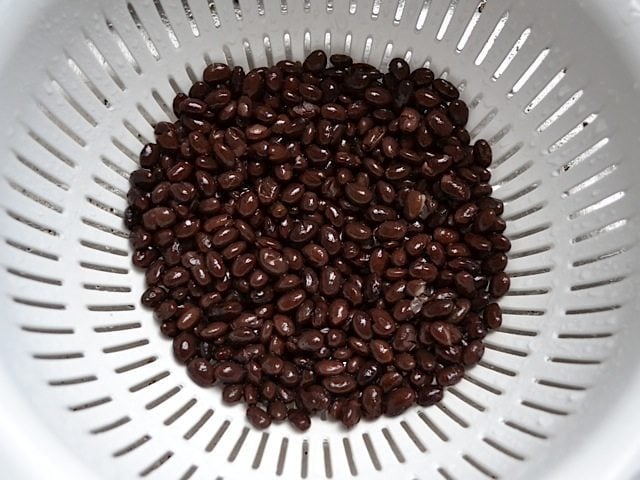 Also, while all that is going on, drain and rinse the beans. Take the corn out of the freezer and let that thaw, too.
Also, while all that is going on, drain and rinse the beans. Take the corn out of the freezer and let that thaw, too.
 Now the rice is probably done so you can fluff that up and build your bowls! Put a cup or so of the rice in a bowl and top with about 1/4 cup each of beans, corn, and pico de gallo. Add some of the sliced steak, a few sprigs of fresh cilantro, and a dollop of sour cream. And that’s that!
Now the rice is probably done so you can fluff that up and build your bowls! Put a cup or so of the rice in a bowl and top with about 1/4 cup each of beans, corn, and pico de gallo. Add some of the sliced steak, a few sprigs of fresh cilantro, and a dollop of sour cream. And that’s that!
 I think the sour cream really adds something great to the bowls… I thought about making an avocado/sour cream sauce, but wanted to keep it simple. That would be awesome, though.
I think the sour cream really adds something great to the bowls… I thought about making an avocado/sour cream sauce, but wanted to keep it simple. That would be awesome, though.
 And when it all starts mixing together… oooooooh. Go make it now!
And when it all starts mixing together… oooooooh. Go make it now!
The post Southwest Steak Bowls appeared first on Budget Bytes.
Kitchen Globetrotter: Peru // Papa a la Huancaína
Charming.goatsSaving for later.
It’s the height of summer picnic season, and if you're like me, you may be getting bored with the old standbys: grilled meats and veg-friendly “meats,” corn on the cob, and of course, cold picnic salads. They all start to run together in a haze of mayonnaise and Italian dressings, but let me suggest a new option: Papa a la Huancaína.
Papa a la Huancaína (Adapted from the Food Network)
Serves 4
6 Yukon gold potatoes or 4 Russett potatoes
8 ounces queso fresco (you can also substitute feta or farmer cheese)
1/3 cup evaporated milk
1/2 cup vegetable oil
3 tablespoons seeded and finely chopped aji amarillo or fresh red chiles
1 garlic clove, finely minced
1/2 lime, juiced
4 large Romaine or Bibb lettuce leaves, washed and dried
3 hard-boiled eggs, peeled and sliced
10 black olives, pitted and sliced (Kalamata or Botija Peruvian olives)
2 tablespoons freshly chopped flat-leaf parsley
photos by overgraeme // shared interest // cc
Insanely Useful Internet Tools + Online Friend-ery
And if you're really keen, you can follow Yes and Yes on Facebook and get gems like Where I Woke Up and a photo album titled Needy Cat.
If you follow me on Twitter, you'll see my 'Fave Read of The Day' each evening and attempts at humor like these:
Read // Eat: 'The Great Gatsby's Lemon Cake

When Nick hosts a tea to reunite Daisy and Gatsby, he relies on the delicatessen to provide a dozen lemon cakes. No wonder he and Gatsby scrutinize them while waiting for Daisy to come over. Homemade lemon cake is a tart and buttery treat that absolutely must be shared. Steep some sun tea and take a page out of Gatsby’s book by inviting friends over for a small gathering.
Psssst! On July 1st, Google Reader is shutting down! If you're reading there, you can follow me on Feedly, Old Reader, or Blog Lovin.'
Places You Need To Visit Immediately: The City Museum
Charming.goatsI need to go to this place!
You guys. It's time to talk about The Best Place That's Ever Happened.
No, it's not Chuck E Cheese.
And it pains me to admit it's not Dollywood.
Friends, the most magical place on earth is The City Museum in St. Louis, Missouri.
My girl Meredith and I hit it up on our road trip and had such an amazing time we:
a) got a little verklempt at all the awesome
b) are organizing a 12-person road trip to go back there in June
If you've ever wished that the game Mouse Trap were real, human-sized, and that you were the mouse, this is the place for you.
If you like activities that should proooooobably require the signing of a waiver, this is the place for you.
If you've got a healthy appreciation from whimsy and weird and danger, OMG welcome home.
Here's why it's awesome:
* giant ball pit with balls that are 6-8 inches in diameter
* a 4-story Ferris wheel ON THE ROOF
* an arts and crafts section where you can make things with glitter and construction paper
* a huge section devoted to the Chicago School of Architecture
* a functioning shoelace factory
* an aquarium with turtles and a 39lb catfish
* tunnels and treehouses and secret hiding spots
* a 10-story spiral slide (!!!)
* a grand piano that everyone has carved their names into and kids can bang on
* rope swings over halfpipes
* a circus school
* awesomely creepy vintage pinball machines and natural history displays
* cocktails (!!!!)
It's just so lovely and refreshing to see a space that's so unabashedly, unapologetically different, you know?
Have you been to The City Museum? What are your favorite weird/exciting/under-appreciated attractions? (We also loved The World's Largest Treehouse and this UFO welcome center.)
All photos by Meredith Westin
House GOP Votes To End Overtime Pay With ‘Working Families Flexibility Act’
Charming.goatsThis is just fucking ridiculous. It makes it too easy for businesses to overload employees for small periods of time and then just not have them work during the slower periods. Good for businesses, bad for employees who are already struggling to make ends meet. I also guarantee there will be companies that claim at the end of the year that they can't pay it.

The GOP-led U.S. House voted to allow employers to replace overtime pay, as currently required by the Fair Labor Standards Act (FLSA), with compensatory time off, or comp time. This sounds great until the bill, inappropriately titled “The Working Families Flexibility Act”, is actually looked at. Despite its claim of increased flexibility, it will make it easier for employers to schedule lots of overtime without paying, and give workers far less flexibility in their lives.
While the comp time would be provided at the same time-and-a-half rate as the FLSA requires for overtime, it would hurt the many low-wage, hourly workers in this country who so frequently depend on overtime pay to make ends meet.
Employers must pay out any comp time no later than 31 days after the end of the company’s year or the end of the calendar year, whichever the company adheres to. While that may wind up being a fairly hefty chunk of pay all at once, it doesn’t help with weekly and monthly expenses for those who are used to depending on overtime pay, though an employee can request payment for any unused comp time at any time under this act.
Furthermore, that accrued and unused comp time is essentially an interest-free loan to the employer, right out of the employees’ pockets. Yes, employers have to pay if the time isn’t used, but they get a 30-day window, even if the employee requests to have comp time cashed out early. With that window, the employee may or may not see the money on their next paycheck, making it harder to plan and to meet unexpected expenses.
The bill also doesn’t contain provisions for allowing workers to use their comp time when they need it, say, for emergencies, sudden illness, parental obligations, surgery, etc. The FLSA is already woefully inadequate when it comes to providing for time off, paid or otherwise, and this does not touch on that issue at all. Ergo, an employer can pay its employees with comp time, but refuse to let them use it when they need it.
One analysis of the bill says it creates incentives for employers to overwork employees who agree to take comp time. Employees can bank up to 160 hours under the law, but those employees who don’t agree to it and want to keep getting overtime pay would probably not get the hours they’re looking for. Indeed, this bill also says nothing about having to provide overtime hours equally to employees regardless of their overtime or comp time status.
Much of that is wildly hypocritical considering Congress is only slated to be in session for 126 days this year. The phrase “overworked and underpaid” will apply to workers even more under this law, while Congress works less and less. They’re paid $174,000 per year to work for less than half of it.
There is also no recourse for employees who find themselves intimidated or coerced into agreeing to comp time, despite this bill’s prohibition against that. Their only recourse is to sue, which is expensive and time-consuming, and may or may not be successful. Employees who manage to get a class certification for such litigation would also likely find themselves with less-than-fair financial compensation from whatever settlement is reached, since that is the typical outcome of class-action lawsuits.
In other words, this law hamstrings hourly workers and puts the few remaining cards they have into the hands of their employers. It doesn’t help families, it hurts them, by continuing to erode workers’ rights.
By Rika Christensen. May 11, 2013.
Source

Anne Frank's Diary Too 'Pornographic' For 7th-Grade Students, Claims Michigan Parent
Charming.goatsOh, FFS
Last week, Gail Horalek filed a formal complaint with the district, alleging that "Anne Frank: The Diary of a Young Girl (The Definitive Edition)" is an inappropriate version of the real-life tale of a Jewish family hiding from Nazis during the Holocaust, according to Patch Northville (which, like The Huffington Post, is owned by Aol).
Speaking with Detroit-based Fox 2 News, Horalek objects to passages in the diary's unedited version that describe Anne Frank exploring her own anatomy -- passages that Horalek says made her daughter uncomfortable.
"It's pretty graphic, and it's pretty pornographic for seventh-grade boys and girls to be reading," Horalek told Fox 2. "It's inappropriate for a teacher to be giving this material out to the kids when its really the parents' job to give the students this information."
The unedited version of Anne Frank's diary is a part of the seventh-grade language arts curriculum at Meads Mill Middle School, where Horalek's daughter attends, according to Patch Northville.
Robert Behnke, assistant superintendent for Instructional Services for Northville Public Schools told Patch the district is following procedure regarding the complaint.
Horalek maintains that the school should have asked before assigning the book, according to a follow-up story in Patch.
"If they watch any kind of movie with a swear word in it, I have to sign a permission slip," she said. "It doesn’t mean my child is sheltered, it doesn’t mean I live in a bubble, and it doesn’t mean I'm trying to ban books."
In 2010, a Virginia school district quietly decided to stop using the "Definitive Edition" in eighth-grade classrooms after a parent complained, according to The Washington Post. Culpepper County Public Schools director of instruction said at the time that district's teachers would use an edited version in the classroom.
The Nation reports that the complaint in Culpepper had to do with a passage in which Anne describes her vagina. However, The Nation also noted that "The Diary of Anne Frank" did not make the American Library Association's (ALA) top 10 list for books banned in American schools between 1990 and 1999.
(Hat tip, Gawker)
By Meredith Bennett-Smith. Posted: 04/29/2013 5:30 pm EDT. Updated: 04/30/2013 8:17 pm EDT.
Source
WHY? WHY? WHY?
Mr. Whack: "I write with my left, but masturbate with my right."
How To Stop Psyching Yourself Out (Or: Settle The Eff Down)
Charming.goatsGood information to remember right now
Dear Sarah Von,
I'm a senior in college and an English major. Over the next two weeks I have over 85 pages worth of papers to write. How do I work hard and stay optimistic without totally psyching myself out?
Oh, friend. I have been there so hard. There was a three-month period in 2007 in which I attended graduate school full time, held two part time jobs, attempted to go vegan and lived with three other people in a two bedroom cottage. What? Yes. How ridiculous am I? And when it came time to write my papers, my coping technique involved staring the computer into submission, crying and then eating several candy bars.
However! That awful three-month foray into insanity taught me a bit about how to chill the eff out in the face of pressure and not completely psych myself out. A few things I learned:
Try your hardest. No, really. Your actual hardest
I don't know about you, but often times I confuse "not being totally lazy" with "trying hard." If I look back on high school, I realize that what I thought was "trying hard" was actually about 50% of what I was capable of. College required about 70% of my best effort and graduate school called for about 90% (with the occasional bit of 95% in that damn grammar class!)
And I think we all know what trying our hardest feels like, in anything that we're attempting:
I find that when I know that I've tried my hardest, that I've done absolutely everything within my power to be successful at a given project, whether or not I succeed becomes almost secondary. You can't do anything else, you've given it all you've got. There's nothing to get psyched out about.
Also - when you've realllly tried your hardest? You're pretty likely to succeed, right?
Consult your cohorts
If you're losing your mind over your millions of term papers, your fruitless job hunt, your never-ending singledom or your frequently rejected manuscript, it's easy to feel like you're the only one going through this. But, shockingly enough, you're not. Other people in the world are stressed out, unemployed, unhappily single or unpublished. While I wouldn't necessarily recommend hunkering down for a three hour bitch-fest with your equally frustrated peers, it feels good to know you're not alone.
Allot yourself a bit of time to winge about this predicament and then see if these friends are trying anything you haven't thought of. Maybe they're friends with a physics whiz or a publishing agent or a single cutie. Maybe they've got some academic references you can use. Combine and use your powers for good!
Take a (tiny little) breather
If you've been going all out, trying your absolute hardest for the last two weeks, you're probably in need of a breather. Energy and creativity need to be replenished, and really? The library has to close at some point. So take some time (two hours, a day, a week) and completely distance yourself from the project. Shower, change clothes, grab lunch somewhere new with someone who's not studying the same thing as you. Take a weekend away and read things that have absolutely nothing to do with what you're working on. Watch a fun, mindless movie. Go dancing and drink a little bit too much. Get a massage. Go rollerskating.
Realize that the world will not end
During graduate school I was having a winge to my fantastic friend Jess, lamenting the possibility of getting a C (shock and horror!) on a paper. She leveled her eyes at me and said "And you know what will happen if you get a C? The world will keep doing this (insert rotating hand motion here)"
And girlfriend was right. I know that these papers, this job search, this grad school application seem like the end-all-be-all right now. But they're not. Really. They're not. I didn't get my driver's license till I was nearly 17. I went through a terrible break up at age 29. I didn't get into the first graduate school I applied to. And you know what? Not dead.
Remember your other strengths
In the event that you really try your hardest on these papers (or apartment hunt. or your gallery submission) and things don't work out, remember that you are not defined by this one small thing. You are not just a student or a writer or an ex-girlfriend. You are a great friend, a sibling, a maker of great sandwiches and the owner of some gorgeous legs.
And the grade on your term papers isn't going to change those things.
How do you deal with deadlines and pressure?




















.jpg)









